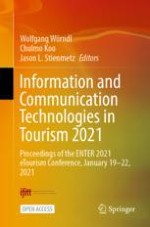1 Introduction
2 Tourist Mobility
2.1 Trust and Destination Safety
-
H1. Trust for COVID-19 CTA is positively related to destination safety.
-
H2. Destination safety is positively related to intention to use COVID-19 CTA.
2.2 Trust and Intention to Use
-
H3. Trust for COVID-19 CTA is positively related to intention to use it
2.3 Trust and Structural Assurance
-
H4. Trust for COVID-19 CTA is positively related to structural assurance.
-
H5. Structural assurance is positively related to intention to use COVID-19 CTA.
-
H6: The relationship between trust and intention to use COVID-19 contact tracing app is moderated by self-efficacy (Fig. 1)Fig. 1.Conceptual framework of our studyFig. 2.COVID-19 model result (Notes. Significant levels *p < 0.05; ***p < 0.001)××
3 Research Methodology
Variables | Items |
|---|---|
Trust (PT) | PT1. COVID-19 contact tracing app is trustworthy PT2. COVID-19 contact tracing app keeps its promise PT3. COVID-19 contact tracing app keeps users’ interests in mind |
Structural assurance (SA) | SA1. COVID-19 contact tracing app has appropriate legal safeguards SA2. am assured that COVID-19 contact tracing app has features that adequately protect me from hacking SA3. believe COVID-19 contact tracing app is safe because it provides adequate protection |
Destination safety (DS) | DS1. Additional security measures at airport make traveling safer DS2. Safety is the most important attribute a destination can offer DS3. Safety is a serious consideration when I am choosing a destination |
Self-efficacy (SE) | SE1. I am skilled at avoiding dangers while using COVID-19 contact tracing app SE2. I am active in securing my environment when using COVID-19 contact tracing app SE3. I am confident that I can remove any hazards while using COVID-19 contact tracing app SE4. I have the ability to protect myself from dangers while using COVID-19 contact tracing app |
Intention (IU) | IU1. I think more and more will use COVID-19 contact tracing app in the future IU1. I think I will use COVID-19 contact tracing app when organising and taking trips IU1. In the future, I will encourage my friends to use COVID-19 contact tracing app |
4 Measurement and Structural Model Analysis
Variables and items | DS | IU | PT | SA | CA | rho_A | CR | AVE | R square |
|---|---|---|---|---|---|---|---|---|---|
Destination safety | 0.854 | 0.855 | 0.911 | 0.774 | 0.093 | ||||
DS1 | 0.866 | ||||||||
DS2 | 0.903 | ||||||||
DS3 | 0.869 | ||||||||
Intention to use | 0.794 | 0.795 | 0.907 | 0.829 | 0.594 | ||||
IU1 | 0.909 | ||||||||
IU3 | 0.913 | ||||||||
Perceived trust | 0.884 | 0.885 | 0.928 | 0.812 | |||||
PT1 | 0.913 | ||||||||
PT2 | 0.920 | ||||||||
PT3 | 0.869 | ||||||||
Structural assurance | 0.871 | 0.873 | 0.921 | 0.795 | 0.626 | ||||
0.879 | |||||||||
0.895 | |||||||||
0.901 | |||||||||
Destination safety | 0.880 | ||||||||
Intention to use | 0.317 | 0.911 | |||||||
Perceived trust | 0.309 | 0.699 | 0.901 | ||||||
Structural assurance | 0.302 | 0.749 | 0.792 | 0.892 |
Hypotheses | Path coefficient | Beta | Std. Dev. | t-values | Confirmation |
|---|---|---|---|---|---|
H1 | Perceived Trust -> Destination Safety | 0.309 | 0.055 | 5.585*** | Sig. |
H2 | Destination Safety -> Intention to use | 0.079 | 0.037 | 2.166* | Sig. |
H3 | Perceived Trust -> Intention to use | 0.269 | 0.059 | 4.541*** | Sig. |
H4 | Perceived Trust -> Structural Assurance | 0.792 | 0.025 | 31.060*** | Sig. |
H5 | Structural Assurance -> Intention to use | 0.512 | 0.055 | 9.275*** | Sig. |
H6 | Self-Efficacy*Trust-> Intention to use | -0.085 | 0.020 | 4.183*** | Sig |
